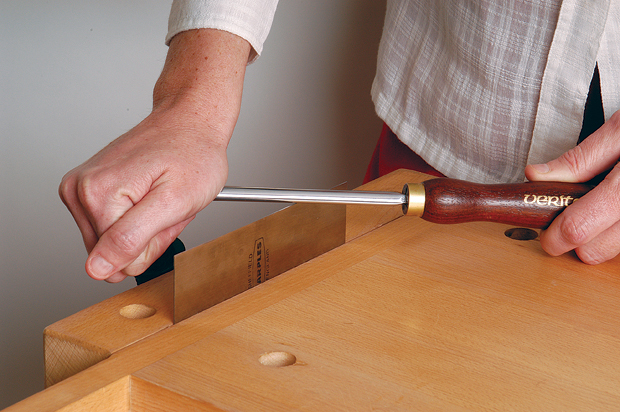Cabinet scrapers are one of the most effective tools in your workshop and, when tuned properly, they are capable of producing a lustrous finish on most timbers. It is hard to imagine how such a simple and inexpensive tool can make such an impact on the quality of your woodworking.
A cabinet scraper is a piece of flat steel, that, when sharpened correctly, will produce fine shavings. The steel must be hard enough to hold an edge, but malleable enough to be able to create a hook or burr. A cabinet scraper may be used to smooth hard timber with difficult grain that is subject to tearout or fiddleback. It can remove machining marks or even out marks left by the sweep of a handplane.
Preparing the edge
This is a simple but effective way of achieving a good working edge on your scrapers. The edge must be straight, clean and at 90° to the flat sides of the scraper. Lock the scraper in a vice and, using a fine flat file, draw it across the edge, being careful not to create a hollow. If there is an old hook, file the sides flat as well as shown below.

Once filed, you need to remove the file marks with a medium to fine diamond or waterstone, (about 800 or 1000 grade.) To avoid cutting grooves in the surface of your waterstone, use the narrow sides to hone your scraper. Be careful to maintain the 90° angle. Once you are happy that there is no hook left at all and the edges are clean and sharp, it’s time to create a new hook, see below.


Making the hook
Although at this stage the scraper is already sharp, you need a hook to achieve a fine shaving. This will act like a small plane blade.
To make the hook you will need a burnisher. There are a few products on the market—I use the Veritas Tri Burnisher or the Veritas Variable Burnisher. This is a much harder steel rod than the scraper, about 62-64 on the Rockwell scale. The surface is highly polished to ensure that the hook is smooth and free of tears that create scratches.
Hold the scraper in a vice and draw the burnisher across the edge of the scraper. You’ll need to make three or four passes, increasing the tilt of the burnisher each time. A tilt of about 10° is sufficient. Don’t use too much downward pressure when making these passes—you will only create a blunt scraper or too large a hook. Medium pressure is all that is required.

If your scraper has been sharpened properly, it will produce fine shavings rather than dust. Bend it slightly and lean it forward so the edge of the hook makes contact with the timber. This angle should be no more than 45°—if you need to lean it more than this, the hook is is probably too acute, and has been applied with too much pressure. With the surface left smooth and the fibres sealed, scraping is a great intermediate step between planing and sanding.
The use of a cabinet scraper will significantly reduce the amount of sanding needed to complete a project, and give a much better foundation for your finish. For curly grain or fiddleback timber it will save you a lot of grief and time.
Reprinted here from Wood Review issue 37.
Carol Russell is a Brisbane furniture designer/maker who also carves spoons and bowls.







